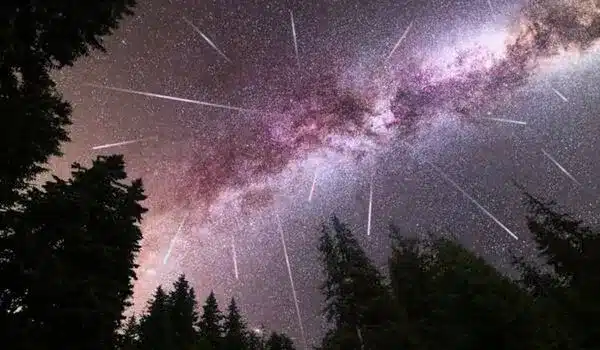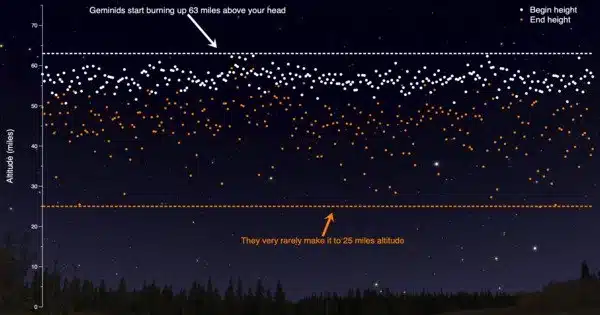Princeton researchers utilized data from NASA’s Parker Solar Probe spacecraft to conclude that the Geminids meteoroid stream was most likely caused by a violent, catastrophic event, such as a high-speed collision with another body or a gaseous explosion. Scientists have long been intrigued by the Geminids’ origins since, unlike other meteor showers, which are caused by a comet’s tail of ice and dust, the Geminids are caused by an asteroid – a chunk of rock that does not ordinarily develop a tail. This peculiar meteoroid stream had previously only been investigated from Earth.
Each winter, the Geminid meteoroids light up the sky as they fly by Earth, resulting in one of the most intense meteor showers in our night sky.
Scientists have long been intrigued by the mystery surrounding the genesis of this meteoroid stream since, unlike most meteor showers, the Geminids are caused by an asteroid – a chunk of rock that does not ordinarily produce a tail. The Geminids had previously only been studied from Earth.
Princeton researchers utilized data from NASA’s Parker Solar Probe spacecraft to conclude that the Geminids were most likely formed by a violent, catastrophic event, such as a high-speed collision with another body or a gaseous explosion. The findings, which were published in the Planetary Science Journal narrow down possibilities about the composition and history of this asteroid that could explain its unusual behavior.
“Asteroids are like little time capsules for the formation of our solar system,” said Jamey Szalay, a research scholar at the Princeton University space physics laboratory and co-author on the paper. “They were formed when our solar system was formed, and understanding their composition gives us another piece of the story.”
Asteroids are like little time capsules for the formation of our solar system. They were formed when our solar system was formed, and understanding their composition gives us another piece of the story.
Jamey Szalay
An unusual asteroid
Unlike most known meteor showers that come from comets, which are made of ice and dust, the Geminids stream seems to originate from an asteroid – a chunk of rock and metal – called 3200 Phaethon.
“Most meteoroid streams are formed via a cometary mechanism, it’s unusual that this one seems to be from an asteroid,” said Wolf Cukier, undergraduate class of 2024 at Princeton and lead author on the paper.
“Additionally, the stream is orbiting slightly outside of its parent body when it’s closest to the sun, which isn’t obvious to explain just by looking at it,” he added, referring to a recent study with Parker Solar Probe images of the Geminids led by Karl Battams of the Naval Research Laboratory.
When a comet approaches the Sun, it becomes hotter, causing the ice on its surface to emit a tail of gas, which drags with its small bits of ice and dust. As the comet remains within the Sun’s gravitational field, this material continues to trail behind it. This repetitive process eventually fills the parent body’s orbit with material, forming a meteoroid stream.
However, because asteroids, like 3200 Phaethon, are formed of rock and metal, they are not normally impacted by the Sun’s heat in the same way as comets are, leaving scientists to speculate on what causes 3200 Phaethon’s stream across the night sky.

“What’s really weird is that we know that 3200 Phaethon is an asteroid, but as it flies by the Sun, it seems to have some kind of temperature-driven activity,” says Szalay. “Most asteroids don’t do that.”
Some scientists believe that 3200 Phaethon is a comet that has lost all of its snow, leaving only a stony core resembling an asteroid. However, new Parker Solar Probe data suggest that, while some of 3200 Phaethon’s activity is connected to temperature, the formation of the Geminids stream was most likely produced by something far more catastrophic than a cometary mechanism.
Opening the time capsule
To learn about the origin of the Geminids stream, Cukier and Szalay used the new Parker Solar Probe data to model three possible formation scenarios, and then compared these models to existing models created from Earth-based observations.
“There are what’s called the ‘basic’ model of formation of a meteoroid stream, and the ‘violent’ creation model,” Cukier said. “It’s called ‘basic’ because it’s the most straightforward thing to model, but really these processes are both violent, just different degrees of violence.”
These different models reflect the chain of events that would transpire according to the laws of physics based on different scenarios. For example, Cukier used the basic model to simulate all of the chunks of material released from the asteroid with zero relative velocity – or with no speed or direction relative to 3200 Phaethon – to see what the resulting orbit would look like and compare it to the orbit shown by the Parker Solar Probe probe data.
He then utilized the violent creation model to mimic the material ejected from the asteroid with a relative velocity of up to one kilometer per hour, as if the fragments had been thrown loose by a quick, violent occurrence. He also simulated the cometary model, which is the mechanism that causes most meteoroid streams to form. The resulting simulated orbit resembled the Geminids’ real orbit the least, according to Parker Solar Probe data, therefore they ruled out this option.
In comparing the simulated orbits from each of the models, the team found that the violent models were most consistent with the Parker Solar Probe data, meaning it’s likely that a sudden, violent event – such as a high-speed collision with another body or a gaseous explosion, among other possibilities – created the Geminids stream.
The study builds on the work of Szalay and several Parker Solar Probe mission colleagues, who built and assembled a picture of the structure and behavior of the large cloud of dust that swirls through the innermost solar system at the Johns Hopkins Applied Physics Laboratory (APL) in Laurel, Maryland.
They used Parker’s flight path – an orbit that brings it millions of miles closer to the Sun than any other spacecraft in history – to gain the finest direct view of the dusty cloud of grains ejected by passing comets and asteroids.
Although the probe does not directly measure dust particles, it may monitor them in an ingenious way: as dust grains pummel the spacecraft along its journey, the high-velocity hits generate plasma clouds. These impact clouds generate distinct electric potential signals, which are detected by numerous sensors on the probe’s FIELDS instrument, which is designed to study electric and magnetic fields near the Sun.
“The first-of-its-kind data our spacecraft is now gathering will be analyzed for decades to come,” said Nour Raouafi, Parker Solar Probe project scientist at APL. “And it’s exciting to see scientists of all levels and skills digging into it to shed light on the Sun, the solar system, and the universe beyond.”












